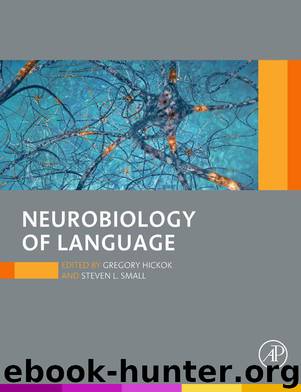Neurobiology of Language by Hickok Gregory; Small Steven L.; & Steven L. Small

Author:Hickok, Gregory; Small, Steven L.; & Steven L. Small
Language: eng
Format: epub
Publisher: Elsevier Science & Technology
Published: 2016-03-16T16:00:00+00:00
46.5 Concluding Remarks and Future Avenues
Although left temporal cortex is consistently implicated in storing long-term representations of knowledge (Binder, Desai, Graves, & Conant, 2009; Indefrey & Levelt, 2004; Vigneau et al., 2006), VLPFC seems to mediate processes necessary for controlling the use of this knowledge. We reviewed evidence from multiple sources in single-word and sentence production and comprehension consistent with a crucial role of this region in implementing top-down biasing at the semantic/lexical level. It is important to point out that this is not restricted to the language domain. VLPFC’s involvement has been shown in selecting the target among nontarget items in target detection tasks, even when items are complex symbols without known lexical labels (Hampshire, Duncan, & Owen, 2007). More generally, VLPFC has been proposed as a critical part of a system involved in processing hierarchical structure of goal-directed behavior (Koechlin & Jubault, 2006).
Although we have made considerable progress in understanding the role of VLPFC in processing language, much remains to be explored. We close by posing four main questions that we consider to be excellent avenues for promoting our understanding of the role of VLPFC in language:
1. How many stages are there in (controlled) lexicosemantic retrieval, and which stage/stages requires VLPFC? Badre and Wagner (2007) proposed that VLPFC implements semantic control in two steps. Step 1 constitutes controlled access to stored representations when bottom-up input is not enough. Step 2 operates postretrieval and is thought to bias competition among representations that have been activated during Step 1. A similar idea has been expressed by Thompson-Schill and Botvinick (2006) using a Bayesian framework. According to Badre and Wagner (2007), both steps recruit VLPFC, albeit different parts of it (BA 47 and BA 45, respectively; Whitney et al., 2012). The exact computations by which this is achieved are not clear.
2. Are subdivisions of VLPFC specialized based on different materials or different processes? An example of a material-based parcellation in the context of language is the semantic-phonological distinction, born out of the differential sensitivity of the posterior parts of VLPFC to phonological, and the anterior parts to semantic processing (Devlin et al., 2003; Gold, Balota, Kirchhoff, & Buckner, 2005; Gough et al., 2005; Poldrack & Wagner, 2004). Studies of statistical mapping between speech errors and lesion sites using Voxel-based Lesion-Symptom Mapping also link damage to the posterior aspects of VLPFC to phonological errors (Schwartz, Faseyitan, Kim, & Coslett, 2012) and its anterior aspects to semantic errors (Schwartz, Kimberg, Walker, Faseyitan, & Brecher, 2009). Similarly, using a version of the technique that maps lesions to parameters in a computational model of language production, Dell, Schwartz, Nozari, Faseyitan, and Branch Coslett (2013) showed that lesions in the more posterior parts of VLPFC correspond to the phonological parameter of the model, whereas lesions in the more anterior parts of VLPFC are associated with semantic errors.
The semantic-phonological distinction, however, does not negate a process-based organization. Semantic and phonological processing may differ not only in the materials they use but also in the operations performed on those materials.
Download
This site does not store any files on its server. We only index and link to content provided by other sites. Please contact the content providers to delete copyright contents if any and email us, we'll remove relevant links or contents immediately.
When Breath Becomes Air by Paul Kalanithi(7263)
Why We Sleep: Unlocking the Power of Sleep and Dreams by Matthew Walker(5641)
Paper Towns by Green John(4169)
The Immortal Life of Henrietta Lacks by Rebecca Skloot(3826)
The Sports Rules Book by Human Kinetics(3588)
Dynamic Alignment Through Imagery by Eric Franklin(3488)
ACSM's Complete Guide to Fitness & Health by ACSM(3467)
Kaplan MCAT Organic Chemistry Review: Created for MCAT 2015 (Kaplan Test Prep) by Kaplan(3423)
Introduction to Kinesiology by Shirl J. Hoffman(3299)
Livewired by David Eagleman(3121)
The River of Consciousness by Oliver Sacks(2992)
Alchemy and Alchemists by C. J. S. Thompson(2911)
The Death of the Heart by Elizabeth Bowen(2901)
Descartes' Error by Antonio Damasio(2731)
Bad Pharma by Ben Goldacre(2729)
Kaplan MCAT Behavioral Sciences Review: Created for MCAT 2015 (Kaplan Test Prep) by Kaplan(2491)
The Gene: An Intimate History by Siddhartha Mukherjee(2491)
The Fate of Rome: Climate, Disease, and the End of an Empire (The Princeton History of the Ancient World) by Kyle Harper(2436)
The Emperor of All Maladies: A Biography of Cancer by Siddhartha Mukherjee(2430)
